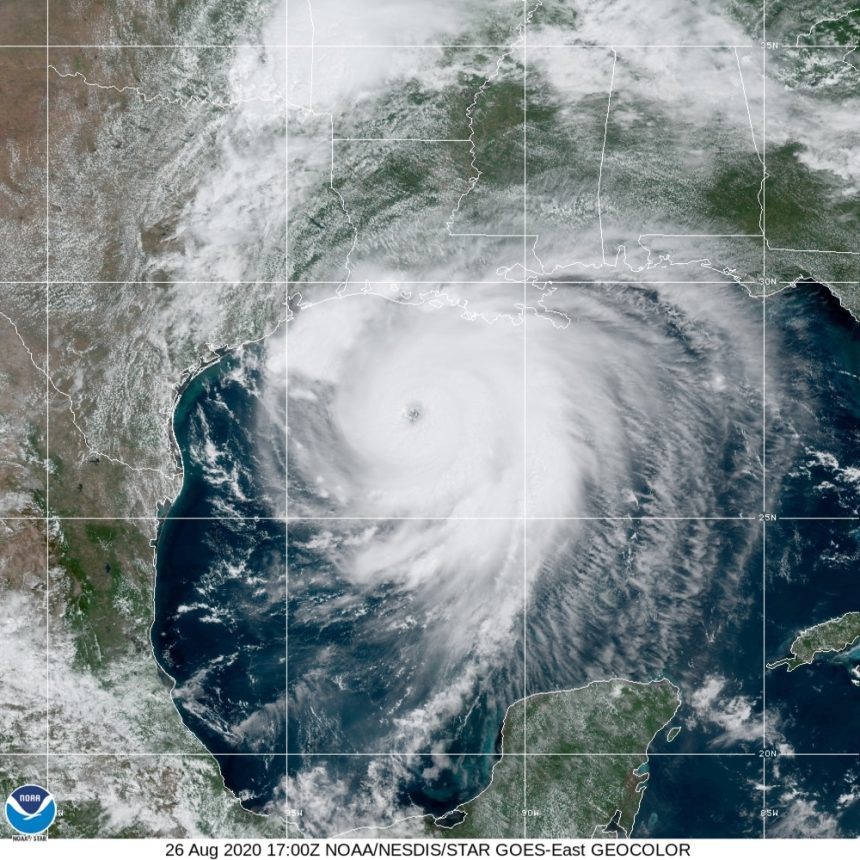Story written by AccuWeather staff writer
Although spring is just in its infancy, a group of AccuWeather meteorologists has been focusing on a different time of year: hurricane season. And based on current weather data as well as long-range climate clues, the forecasters are urging residents in traditional hurricane-prone areas of the United States to make their preparations now.

So what does the 2021 season have in store? According to AccuWeather forecasters, another busy year is in the cards, albeit one that will turn out a bit less hectic than 2020’s nonstop season.
The 2020 Atlantic hurricane season was like no other. Not only did it produce 30 named storms, the most on record, but the United States suffered 12 direct strikes, smashing the previous record of nine from 1916. Forecasters had to turn to the rarely used Greek alphabet for only the second time in history to name tropical systems.
AccuWeather’s team of tropical weather experts, led by veteran meteorologist Dan Kottlowski, predicts that the 2021 Atlantic hurricane season will result in 16-20 named storms, including seven to 10 hurricanes. Of the storms projected to reach hurricane strength, three to five are predicted to become major hurricanes (Category 3 or higher storms that have maximum sustained winds of 111 mph or greater).

New research published earlier this year from University of Miami researcher Brian McNoldy found that there is a new normal for named tropical systems in the Atlantic based on a 30-year average from 1991 to 2020.
AccuWeather’s forecast, when compared to that 30-year average, indicates that 2021 is expected to be an above-normal season for tropical activity in the Atlantic. A normal season is considered to have 14 storms, seven hurricanes and three major hurricanes. Last year, 13 hurricanes formed, and six of those reached the major hurricane threshold.
In terms of the number of storms that will directly impact the mainland U.S., Puerto Rico and the U.S. Virgin Islands, three to five are expected, according to Kottlowski’s team. The annual average number of direct impacts is 3.5.

“Current indications are this will be another above-normal season,” said Kottlowski, who is in his 45th year of issuing forecasts for AccuWeather. “This can translate into high impacts on the United States.”
To come up with the forecast, Kottlowski and his team examined current weather patterns then studied long-range climate models to make a determination about what will happen during the heart of the season in August, September and early October. There are several key factors that will influence the upcoming season.
La Niña or no La Niña? That is the question
One of the determinants for how the season will shape up is the El Niño Southern Oscillation (ENSO). ENSO is defined simply as a short-term climate fluctuation that is determined by warming or cooling of the waters in the central and eastern Pacific Ocean. When the water in the equatorial Pacific is warmer than average, an El Niño is typically declared. When the reverse is true, it’s known as a La Niña.
Current forecasts are calling for the existing La Niña pattern to shift to an ENSO-neutral phase by the late spring or early summer which means water temperatures in this zone of the Pacific will be closer to average.
The big question at this time is whether or not the pattern shifts back to a La Niña by the latter part of the hurricane season, according to Kottlowski.
“If that happens, that could certainly increase the chance that we could see more than 20 storms,” he said.

This GOES-16 GeoColor satellite image taken Wednesday, Aug. 26, 2020, at 2:40 p.m. EDT., and provided by NOAA, shows Hurricane Laura over the Gulf of Mexico. (NOAA via AP)
But what does the water temperature in part of the Pacific have to do with the Atlantic hurricane season?
During La Niña patterns, wind shear becomes less prevalent in the atmosphere over the Atlantic. Vertical wind shear is one of the biggest inhibitors of development for tropical systems. When there is less wind shear in the atmosphere, storms can develop with less obstruction. La Niña conditions were present during the height of 2020’s prolific season.
If La Niña returns and more than 21 tropical storms develop, there could be a new first for the Atlantic. Previously, if 22 named storms formed in one season, which only happened in two hyperactive years — 2005 and 2020 — Greek letters were used to name tropical cyclones. The World Meteorological Organization announced in March that a supplemental name list will now be used once the designated list is exhausted.
Water temperatures in the Atlantic are already above normal
Troubling signs are already emerging in the western Atlantic. According to Kottlowski, sea-surface temperatures (SSTs) are above normal in the northern and central Gulf of Mexico. Waters in much of the Caribbean and tropical Atlantic are also warmer than normal or around normal.
As of March 29, water temperatures off Key West, Florida, were around 81.5 degrees Fahrenheit, which is about five degrees above normal. Yet, that remains a far cry from March 29, 2020, when the water temperature was 87.8 degrees in the area.

This map shows where ocean temperatures are above normal (yellow to red) or below normal (blue to purple) in degrees Celsius. Water temperatures across much of the Atlantic basin are above normal for late March, particularly in the Gulf of Mexico where temperatures ranged from the mid-70s F to low-80s F. (NOAA)
The one exception is the western Gulf of Mexico, where water temperatures at the end of March were cooler than normal due to the historic Arctic outbreak across the South in February. However, those water temperatures are expected to increase by the time the season begins.
The official start date to the Atlantic season is June 1, but in recent years, named storms have become common in May and even as early as April. Kottlowski said that based on current trends and the warm waters in the primary tropical breeding grounds of the Atlantic, he expects a “higher-than-normal” chance of a preseason storm to develop this year.
“Our biggest concern is the fact that water temperatures across the Atlantic are already warmer than normal over a larger part of the basin,” Kottlowski said, adding that it won’t take much to make those water temperatures go even higher through the summer and into the peak of the season.
SSTs were above normal for the entirety of the 2020 tropical season.
Since 2010, seven Atlantic hurricane seasons have had at least one storm form before the June 1 start date. The last season without any preseason tropical development was 2014.
Because of this trend of frequent preseason storms, the National Hurricane Center is considering moving the official start date to May 15 in future years.
Studying the past to predict the future
The high end of AccuWeather’s forecast for direct strikes on the U.S. is five this year. In 2020, five landfalling storms struck Louisiana alone. In fact, southwestern Louisiana was the site of nearly identical landfalls from Category 4 Hurricane Laura in August and Category 2 Hurricane Delta in October.
The Gulf Coast was a frequent target last year, with a barrage of storms unloading on areas from southern Texas to northern Florida. One of the reasons storms kept churning into the Gulf of Mexico was the strength and position of the Bermuda high. This high-pressure area was strong last year and helped force more storms away from the Eastern Seaboard and into the Caribbean and the Gulf of Mexico.

This season, AccuWeather meteorologists believe the Bermuda high will not maintain its strength as frequently as it did in 2020 and they don’t expect it to dig as far south into the Gulf of Mexico and Caribbean. This will promote a greater chance of storms to recurve through the western Atlantic and toward the Eastern Seaboard, according to Kottlowski.
Recurving storms in the Atlantic have a greater chance of impacting the East Coast, whether through higher-than-normal surf or landfalls along the coastline, he explained.
Analog years serve as another data point to reference when piecing together a forecast for an entire hurricane season. Analog years are past years that have weather similar to current and projected weather patterns. Forecasters will often use analog years as a way to determine future trends and predict which parts of the United States could have a high risk.
Several past hurricane seasons that the forecasters studied when generating this forecast were 1996, 2001 and 2012. Based on climate data from those years and similar seasons, the areas at greatest risk for direct impacts from hurricanes or tropical storms are the western and northern Gulf of Mexico, all of Florida and along the North Carolina coast, AccuWeather meteorologists say. Superstorm Sandy caused billions of dollars in damage and killed more than 145 when it slammed into the East Coast in late October of 2012.
Keeping a close eye on Africa
Hurricanes often form in the far eastern Atlantic after tropical waves that float across Africa emerge over the open waters of the Atlantic and quickly strengthen into more robust storms. A normal to above-normal number of tropical waves is predicted to develop off the African coast this season, due to a weather influencer known as the African easterly jet, which consists of strong low to mid-level winds in the atmosphere over central Africa.
Development is often hindered earlier in tropical seasons due to the presence of dry air and dust that makes their way over the open Atlantic from the Sahara Desert. That is expected to be the case in 2021 as well, Kottlowski said. However, by the peak of the season, the dry air and dust will become less common, which should allow for more tropical development.
How intense could this season be?
Accumulated Cyclone Energy (or ACE) is a metric meteorologists use to determine how intense the year is for a particular tropical basin. Although 2020 was busier than any other season on record, it wasn’t the most intense hurricane season. It produced an ACE value of 182, which is less than the 2017 season’s total of 225 and the whopping 245 from the 2005 season, according to records kept by Colorado State University researchers.
For 2021, AccuWeather forecasters expect a slightly above-normal season when it comes to intensity. An ACE value of 120-160 is predicted; the 30-year average for Atlantic seasons is 123.
ACE doesn’t necessarily tell the whole story, Kottlowski cautioned. Just because a season has a lower ACE value than another, that doesn’t necessarily mean storms will be less damaging to the United States.
‘The time is now for you to plan‘
While there are still two months to go until the official start of the Atlantic hurricane season, Kottlowski says now is the time for residents of hurricane-prone regions to formulate a hurricane safety plan and study up on evacuation routes and nearby shelters.
It doesn’t take a major hurricane to cause life-altering damage to a person’s property. Even a slow-moving tropical storm has the potential to dump feet of rain and trigger life-threatening flooding.
The season doesn’t officially end until Nov. 30 and 2020 is a good reminder of that. Hurricanes Delta and Zeta both struck the Lousiana coast last October. However, tropical activity persisted all the way into mid-November last season, as Central America was struck by two major hurricanes, Eta and Iota, within the span of two weeks.
“Please educate yourself now,” Kottlowski said when asked what message was important to convey to people living in hurricane-prone locations.
“Another issue that we will face still is the COVID-19 pandemic,” he said. “This is still going to cause major concerns for evacuation centers. Don’t wait until August or September, during the heart of the hurricane season, to figure out what you’re going to do. The time is now for you to plan.”







